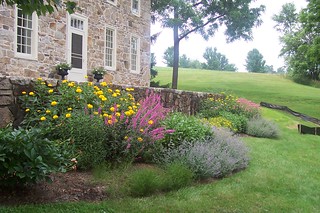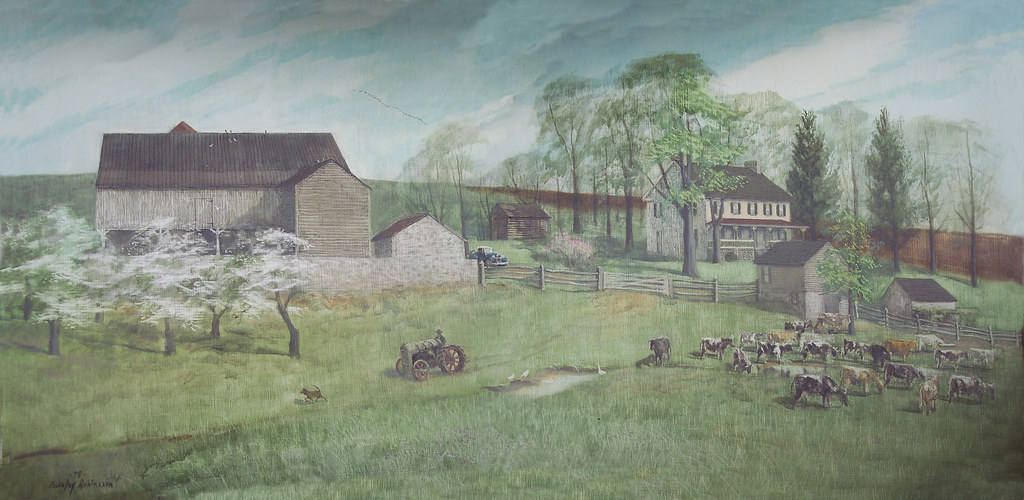"Brae"
I've done a little research on the history of Braefield Farm, and was lucky to find a title search of the property had been done through the 1930's. The Chester County Historical Society also had a family history of the original family at Braefiled Farm, the Sloanaker family.
Michael and Susanna Sloanaker, both born in PA but of German ancestry, purchased 130 acres in Chester County PA in 1793. There is a stone in the gable end of the house that has the initials M & S and the date 1807 carved into it, I think it is Michael and Susanna's initials. Interesting that it took 14 years to get the house built.
The Sloanakers were here until 1843 when they sold the farm to the Pugh/Pew family.
I think the Pugh family is Welsh. There is a town about 6 miles away called Pughtown and the founders of that town were Welsh. I'm guessing it was the same family. The Pughs were still at the farm into the 1930's.
My guess is that the Pugh family gave the farm it's name, Braefield Farm.
I don't know why I thought "brae" meant beautiful, but when I looked it up I found out I was wrong.
I can find references to "brae" in Welsh place names and literature, but it's not defined as such in a Welsh dictionary.
Brae is from the Old Norse for eye brow or lash and is thought to have been extrapated to brow of hill... to hillside according to several Scottish sources I found.
So Braefield Farm = Hillside Field which fits since the farm is on a hillside.
I will have to get a better picture from the top of the hill, but you can see a hillside in the background here.
Welsh and Scottish are related distantly..
The closest relatives of Welsh are the other p-Celtic languages, of which the other modern representatives are Cornish and Breton, which are also descendants of Brythonic...
The next nearest relatives are the family of q-Celtic languages, of which modern representatives are the Gaelic languages of Ireland, Man and Western and Highland Scotland...
Well I'm sure this is way too much information, but I enjoyed looking at the reference material.
Michael and Susanna Sloanaker, both born in PA but of German ancestry, purchased 130 acres in Chester County PA in 1793. There is a stone in the gable end of the house that has the initials M & S and the date 1807 carved into it, I think it is Michael and Susanna's initials. Interesting that it took 14 years to get the house built.
The Sloanakers were here until 1843 when they sold the farm to the Pugh/Pew family.
I think the Pugh family is Welsh. There is a town about 6 miles away called Pughtown and the founders of that town were Welsh. I'm guessing it was the same family. The Pughs were still at the farm into the 1930's.
My guess is that the Pugh family gave the farm it's name, Braefield Farm.
I don't know why I thought "brae" meant beautiful, but when I looked it up I found out I was wrong.
I can find references to "brae" in Welsh place names and literature, but it's not defined as such in a Welsh dictionary.
Brae is from the Old Norse for eye brow or lash and is thought to have been extrapated to brow of hill... to hillside according to several Scottish sources I found.
So Braefield Farm = Hillside Field which fits since the farm is on a hillside.
I will have to get a better picture from the top of the hill, but you can see a hillside in the background here.
 |
| Southern face border |
Welsh and Scottish are related distantly..
The closest relatives of Welsh are the other p-Celtic languages, of which the other modern representatives are Cornish and Breton, which are also descendants of Brythonic...
The next nearest relatives are the family of q-Celtic languages, of which modern representatives are the Gaelic languages of Ireland, Man and Western and Highland Scotland...
Well I'm sure this is way too much information, but I enjoyed looking at the reference material.
Labels: Braefield Farm Restoration



0 Comments:
Post a Comment
<< Home